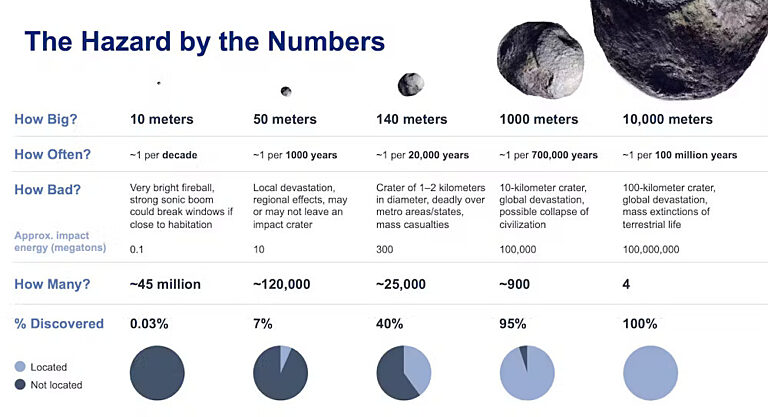Jatan Mehta & Asa Stahl • May 10, 2022
When to worry about an asteroid impact
The asteroid that wiped out most of the dinosaurs — as well as roughly 80% of all species on Earth — was huge, but rare. At about 5 to 15 kilometers (3.1 to 9.3 miles) across, an asteroid like that is expected to only hit Earth once every hundred million years or so.
But what about something a little smaller?
Between the planet-killer asteroids that almost never hit Earth and the little pebbles that constantly do, there's a danger zone. Asteroids and comets that are 50 to 150 meters (164 to 492 feet) across can wipe a city off the map, and they strike as often as every thousand years. Today, there are well over ten thousand known asteroids and comets at least this large known to pass near Earth. These near-Earth objects, or NEOs, typically have small chances of hitting us. But they're not zero.

How to tell if an asteroid is dangerous
Unlike the dinosaurs, we can find and track hazardous NEOs to predict how likely they are to hit Earth years before they actually might. That would give us crucial time to deflect an incoming danger. This effort to save our planet from major impacts is known as “planetary defense,” and it's why we don't need to panic about asteroid strikes. Clickbait media headlines about small asteroids flying past Earth or entering our atmosphere might sound concerning, but they make the problem appear more alarming than it is.
“There are no known [sizable] asteroids on a collision course with Earth for the foreseeable future. NASA always makes information about NEOs available at cneos.jpl.nasa.gov/sentry,” said Nancy Chabot, a planetary scientist at Johns Hopkins Applied Physics Laboratory.
If we ever learn that a sizable asteroid is predicted to impact Earth in the not-so-distant future, you can rest assured that NASA and other space organizations globally will send out press releases and updates on all their channels.
That being said, the time to prepare for future asteroid strikes is now — before we discover one on a collision course.
Why we need planetary defense now
We don’t know how many dangerous NEOs are out there on track to eventually hit Earth. While movies like Armageddon and Don't Look Up have brought some attention to the potential threat of an impact, it took nearly 25 years to convince policymakers at space agencies around the world that investing resources to identify, track, and deflect NEOs is necessary for the safety of everyone on Earth. Even then, efforts only really started accelerating over the the last decade or so, when the U.S. White House, catalyzed by a key report from the National Research Council, proposed a five-fold increase in funding to discover NEOs.
Increased U.S. funding for planetary defense also led to the launch of the Double Asteroid Redirection Test (DART) in 2021, the world’s first mission to intentionally crash into an asteroid. DART helped test our ability to deflect potentially dangerous asteroids. Now, the European Space Agency (ESA)'s Hera mission is investigating the aftermath. Two more upcoming missions, NASA's OSIRIS-APEX and ESA's (still unofficial) Ramses, are set to help us find out more when the asteroid Apophis just barely misses Earth in 2029.
Finally, there's NEO Surveyor: NASA’s long-planned space telescope that aims to discover at least 90% of all city-killer NEOs. Though telescopes on Earth can discover and track asteroids, they are affected by bad weather, have a hard time discovering small bodies near the Sun, and lack coverage of the Southern Hemisphere. By comparison, NEO Surveyor will be much more efficient, and it will also be able to use infrared measurements to find dark asteroids that would otherwise be hard to spot.
The Planetary Society has been a stalwart supporter of this critical planetary defense mission for many years. Thanks in part to our efforts, NASA finally "confirmed" the mission will now launch in 2027-2028.
Chabot, who was also a project scientist for the DART mission, stressed the importance of warning time that missions like NEO Surveyor will give us. “Many movies have the plotline that an impact is happening very soon, and then the characters scramble to try to prevent it. But a little bit of sustained effort now to find all the asteroids is key to not being in that situation, and that is the foundation of a good planetary defense strategy — starting with missions like NEO Surveyor.”

What The Planetary Society is doing for planetary defense
Between 2020 and 2024, Planetary Society members and supporters sent letters to their representatives in government urging them to fund NEO Surveyor, and the mission was a key talking point in our annual Day of Action congressional visits. This hard work paid off when Congress finally funded the mission in 2024.
The Planetary Society also funds a network of everyday heroes around the world to find, track, and characterize NEOs. We have been awarding these Shoemaker Grants for over 25 years. Separately, we have also supported a team of scientists developing a new method to help us understand NEOs, since knowing the physical makeup of NEOs is crucial to effectively defending against them.
So long as we continue to prepare for it like this, we don't need to lose sleep over a large asteroid hitting Earth within our lifetime. After all, an impact is a matter of "when" — not "if."
Acknowledgments: this page was initially written by Jatan Mehta in 2022. It was revised by Asa Stahl in 2025.
Support our core enterprises
Your support powers our mission to explore worlds, find life, and defend Earth. You make all the difference when you make a gift. Give today!
Donate

 Explore Worlds
Explore Worlds Find Life
Find Life Defend Earth
Defend Earth

